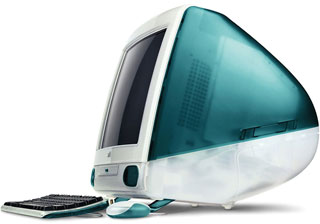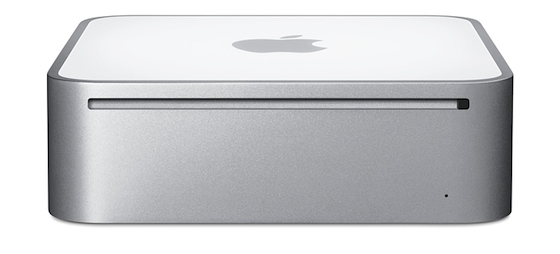July 1998: Don Crabb was the first to speculate in public that the iMac wouldn’t stand alone for long (The iMac Line, Don Crabb, MacCentral, 9 June 1998). I have to agree with him.
 The iMac is as revolutionary as the original Macintosh – without breaking software compatibility (see The iMac: truly revolutionary). And just as the first Macintosh gave birth to the Fat Mac, Mac Plus, Mac II, and dozens of other models, I believe the iMac will soon be seen as the ancestor of a whole family of iMacs.
The iMac is as revolutionary as the original Macintosh – without breaking software compatibility (see The iMac: truly revolutionary). And just as the first Macintosh gave birth to the Fat Mac, Mac Plus, Mac II, and dozens of other models, I believe the iMac will soon be seen as the ancestor of a whole family of iMacs.
Apple has changed the paradigm from components to integration. You don’t buy an iMac, then add a monitor and a modem. All the important parts are right there when you buy it. USB will make adding a cable modem, Zip drive, or scanner easier than ever.
The iMac can easily become several niche computers.
The Network iMac
Already equipped with a fast Ethernet port, the iMac is ready for business and school. Drop the unnecessary modem and bump standard RAM to 64 MB, and you have the ideal network computer at the same price.
Update: This was one potential idea when Apple was developing the iMac, but network computers never became a big thing.
The Expandable iMac
Take the Network iMac and put a Device Bay where the CD-ROM resides. Then add FireWire. Put an extra DIMM slot on the motherboard and leave out the modem.
This lets the buyer choose CD-ROM, DVD, or a removable media drive for the Device Bay – and you can hot swap them at will. FireWire provides access to fast external hard drives and video equipment.
For perhaps $200-300 more than the basic iMac, the serious Mac user who doesn’t find a 15″ screen constraining has a lot of options.
 Update: Device Bay never came to the iMac, but FireWire came with the slot-loading iMacs introduced in October 1999, just 14 months after the first iMacs shipped. The top-end model even had a DVD-ROM drive. The Early 2001 iMacs dropped DVD-ROM in favor of CD-R.
Update: Device Bay never came to the iMac, but FireWire came with the slot-loading iMacs introduced in October 1999, just 14 months after the first iMacs shipped. The top-end model even had a DVD-ROM drive. The Early 2001 iMacs dropped DVD-ROM in favor of CD-R.
The Modular iMac
This is where we start getting serious: an iMac without a built-in monitor, with one or two PCI slots, with FireWire, and with one or two Device Bays. Cute, compact, and inexpensive, this could eventually replace the Power Macintosh series.
Update: Never happened. There was no “headless iMac” with PCI slots or Device Bays. The Mac mini came the closest to the concept, but no expansion slots or bays.
The AV iMac
Take the Modular iMac, build in a 17″ monitor and better sound, and you have the AV iMac. Hefty, powerful, and still visually attractive.
 Update: We saw the first 17″ iMac in July 2002, an 800 MHz G4 model with a widescreen 1440 x 900 pixel display. The January 2002 15″ iMac G4 was the first with a SuperDrive, so it could burn both CDs and DVDs. The G4 iMacs with external speakers definitely had better sound than the G3 iMacs. When the iMac G5 arrived in August 2004, 17″ was the smallest model, and that size remained in production until the Late 2006 iMac was discontinued in August 2007 and 20″ became the smallest model.
Update: We saw the first 17″ iMac in July 2002, an 800 MHz G4 model with a widescreen 1440 x 900 pixel display. The January 2002 15″ iMac G4 was the first with a SuperDrive, so it could burn both CDs and DVDs. The G4 iMacs with external speakers definitely had better sound than the G3 iMacs. When the iMac G5 arrived in August 2004, 17″ was the smallest model, and that size remained in production until the Late 2006 iMac was discontinued in August 2007 and 20″ became the smallest model.
The Portable iMac
Some people need the power of a PowerBook G3 without the price. And they don’t need to run off a battery.
For these Mac users, an iMac with an LCD display cuts the iMac’s weight without compromising performance. The design could be a hybrid of iMac and PowerBook, lightweight and inexpensive. Provide just enough battery power to retain memory in sleep mode for a day or two and you’d have a great portable computer.
Although the display would increase this model’s price, the ability to dispense with expensive power management features could make it a very attractive alternative to the PowerBook.

Update: Another thing that didn’t happen. The Mac mini came closest to the concept, but it wasn’t designed to use a battery for sustain it in sleep mode. Other than that, pretty close!
The iMac Family
This is all speculation, but it makes sense that Apple would capitalize on the new iMac brand recognition. It’s much easier to say iMac than Power Macintosh G3 All-in-One, or even Power Mac G3. And within a year, if not months, the iMac brand will become as recognizable as the Apple brand, the PowerBook name, and the “up to twice as fast” G3 processor.

Apple’s survival depends not just on great computers, but on memorable ones. The iMac will be that and deserves to father a whole new line of computers.
Update: February 2018, nearly 20 years after the iMac was introduced, and it’s still selling well. And for the first time in the iMac’s history, there’s even a top-end model called iMac Pro!
Further Reading
- The Tiny iMac, Dan Knight, the iMac channel, 1998.08.06
- iMacs a Plenty?, Don Crabb, MacCentral, 1998.08.05
- The iMac Line, Don Crabb, MacCentral, 1998.06.09
keywords: #imac #imacfamily

